All-wheel-drive is a feature many people want – which accounts for the popularity of crossovers, which almost always offer it and sometimes even come standard with it.
But for some reason, it’s hard to find an entry-level compact sedan or hatchback that offers it.
Well, it was.
Mazda now offers the extra grip – and better handling – of all-wheel-drive with the new Mazda3, which gives it a leg up over rivals like the Toyota Corolla, Honda Civic and Kia Forte – which don’t offer it at all.
And over the Subaru Impreza, which does offer it – and for less – but with a lot less power.
On the downside, there are some things the Mazda doesn’t offer – like an optional engine or the option to choose a manual transmission, if you choose the sedan – options which several of its FWD-only rivals (and the AWD standard Impreza) do offer.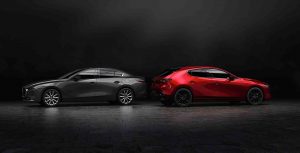
As always, you pays your money and you takes your choices.
What It Is
The 3 is Mazda’s entry-level compact-sized sedan/hatchback sedan; it’s in the same class as rivals like the Toyota Corolla, Kia Forte and Honda Civic.
It differs from all of the above in being one of just two models in this price range that’s available with all-wheel-drive.
The other one being the Subaru Impreza – which comes with it standard.
It’s also one of the few new cars in this class that still comes with a conventional automatic transmission rather than a continuously variable (CVT) automatic transmission – which is the Impreza’s optional automatic.
However, there is no longer a manual transmission option – unless you buy the more expensive hatchback – and then you can’t opt for AWD.
Prices start at $21,500 for the base trim sedan with front-wheel-drive and a 2.5 liter four cylinder engine paired with a six-speed automatic transmission.
A top of the line Premium trim sedan with all-wheel-drive (and the same automatic) stickers for $27,900.
The hatchback starts at $23,700 – $27,500 if you want to shift for yourself.
What’s New
The 3 gets AWD as an option – and (unfortunately) a suite of standard “safety” features, including lane keep assist and a drowsy driver monitor.
What’s Good
It’s one of just two cars in the class that offers AWD.
Powerful standard engine – without a turbocharger.
One of the few small sedans still offered with a conventional automatic transmission – with gears – rather than a continuously variable (CVT) automatic transmission.
What’s Not So Good
AWD comes standard in the Impreza – for less ($18,695 to start).
Sedan is automatic-only.
Manual-equipped hatch is FWD-only.
Regardless of trim or bodystyle, every 3 comes standard with the same engine – which was last year’s optional engine. It’s a 2.5 liter engine that makes 186 horsepower and 186 ft.-lbs. of torque.
Without a turbo. And so, without any worry about ever having to replace one down the road, after the warranty expires.
The Honda Civic’s optional 1.5 liter engine – with a turbo (and a higher price) only makes 174 horsepower. The Toyota Corolla sedan’s standard 1.8 liter engine hasn’t got a turbo – but only gives you 139 horsepower. If you upgrade – and pay extra – you can get a new Corolla with a larger 2.0 liter engine – also sans turbo – and sans horsepower (169 hp) vs. the Mazda’s standard engine.
This is an example of the old saying that there’s no replacement for displacement. And it’s not just an old saying. It’s an engineering truth. Smaller engines make less power unless they flow more air – which can be accomplished via force-feeding them air. By bolting on a turbo. This is a round-about way of getting equivalent power out of them vs. a larger engine without the turbo.
But why not just go with the larger engine – and skip the turbo – as Mazda has?
Because the government keeps demanding that new cars deliver higher gas mileage, which can be done by making the engines smaller. But then customers get an underpowered engine.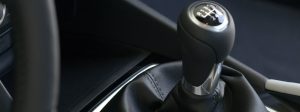
Mazda splits the difference.
The larger-engined, not-turbo’d 3’s 26 city/35 highway isn’t quite as high as the 1.8 liter Corolla’s 30 city, 38 highway – but when you factor in the power disparity – 47 hp – it works out in the Mazda’s favor. And while the much smaller turbocharged 1.5 liter engine that’s available in the Civic delivers 32 city/42 highway, it only does so for $23,700 – which is $2,200 more than the base price of the Mazda.
Which buys a lot of gas – to make up for it.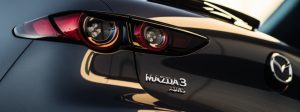
But, there’s no optional engine in the 3 – either way – which makes the 3 more expensive than the Subaru Impreza, which you can pick up for just $18,695 to start – with AWD standard. But the Soobie doesn’t offer an optional engine – and comes standard with much less power.
The hatchback version of the 3 also comes standard with the same 2.5 liter engine – and the option to go manual, if you prefer. However, the six-speed manual is optional – it adds to the car’s price – and you can’t pair it with AWD, which is only available with the six-speed automatic.
If you buy the sedan version of the 3, you get a six-speed automatic transmission (with paddle shifters in Premium trims) and your choice of FWD or AWD.
The 3 may not offer an optional engine but its standard engine is the strongest in the class, as noted above. And especially relative to its only AWD-equipped rival, the Subaru Impreza – which offers nothing larger than a 2.0 liter engine that manages just 152 horsepower.
Subaru does offer the Impreza with a five-speed manual transmission, but the automatic-only Mazda is much quicker, posting a 0-60 time of about 8 seconds flat vs. about 11 seconds for the Impreza.
With the manual six-speed, the 3 hatchback is even quicker, getting to 60 in about 7 seconds flat.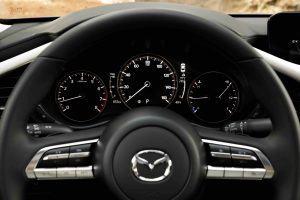
Interestingly, the Mazda also has more ground clearance than the Soobie – 5.5 inches vs. 5.1. It’s not a huge difference, obviously. But it does mean that when the flakes fall, it’s the Mazda that might be the better tool.
And when it’s dry – it’s no contest. The Mazda isn’t just a little quicker; it’s so much quicker you ‘ll need to pull over, park and wait for the Subaru to catch up coming out of every curve.
There is also something to be said for not having AWD – and having power, without having to pay extra for it, as is the case with Corolla and Civic.
And it’s very nice to not have a CVT automatic.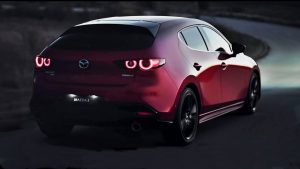
Just as Mazda is among the few car companies that has not bolted a turbo to practically every engine it sells, it is also one of the few car companies that isn’t putting CVT automatics into everything it sells.
CVTs today are much better, overall, than they were a few years ago – but many people do not like their operating characteristics. CVTs are, fundamentally, economy transmissions designed to maximize a car’s fuel efficiency by optimizing leverage. The idea is to maintain the idea mechanical ratio between engine, transmission and driver wheels at all times – by eliminating fixed forward gears in favor of one continuously adjusting ratio.
But eliminating shifts results in rubber-bandy acceleration feel and – often – more driveline noise. CVTs also seem to be not-as-tough (or as durable) as conventional automatics. In any event, if you don’t want one, avoiding one isn’t easy.
Unless you shop Mazda.
Both the sedan and the hatch have interiors – as well as standard features – that would have qualified them both as entry-luxury cars as recently as five years ago. These include the iPad-like 8.8 inch LCD touchscreen in the center stack as well as the standard adaptive cruise control and the available Heads-Up Display (HUD), which projects information such as your current speed in a holographic display in your line of sight, so you don’t have to take your eyes off the road to know how fast you’re going.
Another luxury-level amenity the 3 offers is an exceptionally high-fidelity 12 speaker Bose ultra-premium surround-sound audio system. It is the kind of audio system that you used to have to buy a luxury-badged (and luxury priced) car to get.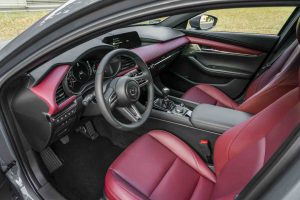
But not anymore.
And the standard audio system comes with eight speakers.
Both versions of the 3 are good-looking versions, too. Neither looks entry level, at any rate. Mazda is one of the few companies that still views cars as more than transportation appliances.
Style is still important here.
As far as utility:
The hatch has about twice the cargo space as the sedan – which has a 13.2 cubic foot trunk – but less rearward visibility due to the slope of the rear glass; the sedan also has better visibility on either side because it doesn’t have the large “C” pillars that the hatch has.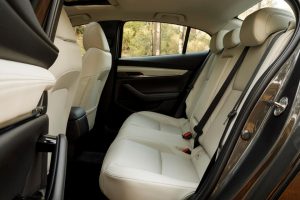
Like others in this class, there is a big difference in front vs. rear seat legroom. The driver and front seat passenger enjoy 42.3 inches of legroom – comparable to a full-size luxury car. But those in back get just 35.1 inches – unless those up front slide their seats forward a few inches.
This is still par for the class, however.
And style isn’t optional in most of the 3’s rivals.
The Rest
One thing – several things – the new 3 comes standard with that you may wish it didn’t come standard with is a suite of saaaaaaaaaafety and driver “assistance” tech, including Lane Keep Assist, Automated Emergency Braking and a “drowsy driver” warning system.
It’s odd that Mazda would include these things – as opposed to offering them – as Mazda is a company that appeals to drivers – not cell phone tappers. Or mindless traffic law obeyers. One of the many annoying things about Lane Keep Assist is that it tries to keep you in your lane when you’re trying to leave it, as when threading the needle through traffic. The system will exert countersteering force if you don’t signal before every lane change – even when you’re the only car on the road.
Similarly, the automated emergency braking system will brake when there isn’t an emergency – just another car ahead that gets within the “too close” orbit of the system’s sensors. But “too close” is programmed in accordance with your glaucomic grandma’s ideas of such things.
Luckily, these things can be turned off. But you shouldn’t have to buy them in the first place.
The Bottom Line
If you need AWD – and don’t want to buy a crossover – or do without power – now you don’t have to!
. . .
Got a question about cars, Libertarian politics – or anything else? Click on the “ask Eric” link and send ’em in!
If you like what you’ve found here please consider supporting EPautos.
We depend on you to keep the wheels turning!
Our donate button is here.
If you prefer not to use PayPal, our mailing address is:
EPautos
721 Hummingbird Lane SE
Copper Hill, VA 24079
PS: Get an EPautos magnet or sticker or coaster in return for a $20 or more one-time donation or a $10 or more monthly recurring donation. (Please be sure to tell us you want a magnet or sticker or coaster – and also, provide an address, so we know where to mail the thing!)
My latest eBook is also available for your favorite price – free! Click here. If that fails, email me at [email protected] and I will send you a copy directly!


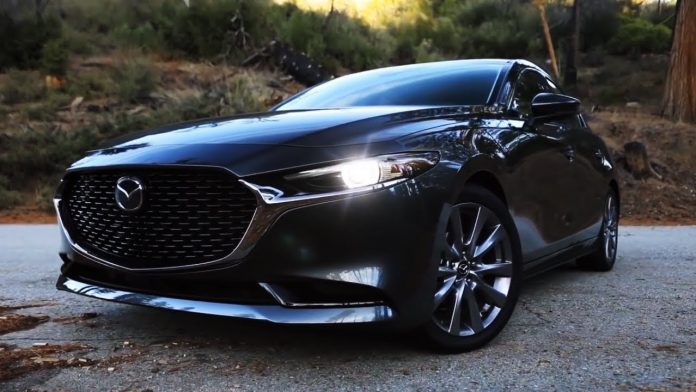


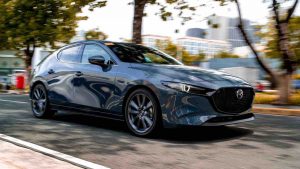








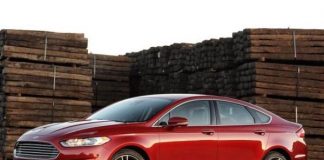
How’s this thing for shoulder room?
I’m 6’3″ and disproportionately wide?
The old yardsticks: Full size > compact seem to have slipped somewhere along the way
Hi Bill,
I’m the same height – and have wide shoulders. I found it very comfortable – for me. But your mileage may vary. I almost never comment on “fit” because it’s extremely subjective. One really needs to go sit in the car – whichever car it is – and take it for a drive oneself to know how it fits you!
Nice car, and the simplest of many (relative). I will recommend it to friends.
I used to recommend the 1st Gen Cruze, but they are no more. I didn’t like the 2nd Gen Cruze that much.
Thanks.
Where is it built?
Japan and Mexico. Mine was made in Japan. There is assumed to be no difference in quality between the two factories.
I bought this car, a 2019 Mazda3 Hatchback AWD. It’s a great car. The AWD system is “always on” and working to predict traction loss and shuttle power around before it happens (unlike other systems that wait for wheel slip). The result is a huuuuge amount of grip in the dry/wet and very good performance in the snow. It’s WRX-like in it’s ability to get up snowy and slippery inclines, for example.
Eric, I know you’re opposed to “safety nanny” features, but the ones in this car aren’t very intrusive. Yes, the lane keep assist tugs at the wheel a bit when you change lanes, but if you signal it doesn’t cut in. And, like you said, you can turn it off. Or, in the system menus, you can customize the level of intrusion from just a “beep” to a “beep and a shake” to “just a shake” etc…
This car also has something called “G-vectoring control” that cuts engine torque on corner entry to load the front wheels and improve grip. It also drags the outside brake on corner exit to straighten the car out faster. The steering is direct and sensitive as well. The result is a car that corners so naturally and happily. Very little body roll and tons of mechanical grip (even on all seasons) yields a car that is very much at home on fast, twisty roads.
The only “downside” to the car is the engine. Yes, it is the highest HP and torque in it’s class, but the 2019/2020 Mazda3 chassis and suspension are so *good* that I (and pretty much every car reviewer out there) feel the car needs ~220-250 HP to really perform. With that kind of power, the car would be a legit competitor for the Golf GTI and the Veloster N.
Still, it’s a fantastic small car, and one that the public completely ignored in favor of CUVs, like the CX-5. It has sold like crap, which means if you buy one, you will have the ONLY one in your town/city. Which is cool. I feel like I’m driving a Ferrari in my Soul Red Hatchback.
I always see the turbocharger’s reliability questioned. Mine finally went last month on my TDI. It made it 22 years, 480,000 miles.
AWD is a bigger issue for me, I see that as unneeded components that may fail, and probably robs HP. I also was told years ago insurance rates are higher for 4wd vehicles. Wonder if that still applies?
Mazda 3’s engine is a 2-cylinder (sometimes) using cylinder-deactivation –I’ll pass.
The 2.5 with cylinder deactivation has been discontinued in the US across the line. The standard 2.5 does not have it.
AWD is overrated. I live in such a snowy climate that I didn’t even bother taking my snow tires off last year. Up here, the cheapest and lowest mileage-rated all seasons will dry rot before you wear them out.
I haven’t owned a Mazda since 1987, but I do love the brand. That 1981 626 with the 2.0 liter and 5 speed wasn’t big on power, but the handling was superb. Of course, it was RWD, and being a geezer all my instincts revolve around that configuration.
Hi Craig,
I am with you on this AWD business – which has been oversold, made possible by the Safety Cult’s propagation of fear that if you haven’t got it, better not go out when it looks like it might snow!
Saaaaaaaaaaaaaaaaaaaaaaaaaafety!
I used to be all AWD, until I’ve experienced getting stuck in my driveway and in snow, with my manual A4 with decent AS tires, and then getting up and down my parents driveway (they live up a hill) with my old Mustang with Michelin’s when everything else would get stuck
ONLY time you’d need AWD is racing, when you need the initial edge or to handle tons of power, otherwise just get good tires
Thanks for posting a car review. It’s nice to have a topical diversion from You Know What.
For a long time, Mazdas generally were the slowest, but best handling, and among the best looking cars in their class. That “slow factor” made them totally unacceptable to me. But recently, they have been changing that paradigm. And now, the 3 is one of of the few entry level compacts you can get “without” CVT.
Used to be, if faced with a decision between a Mazda, Subaru, Toyota or Honda, I’d buy the Honda car, or the Toyota if I needed a truck. Now…if I were looking for a car in this class, the 3 would be on the short list…fairly near the top.
Thanks, Mike!
I’m trying me best to maintain sanity amid lunacy – the worst of the latter being that manifested by so many people who seem so willing to surrender their lives to the government in exchange for the government “saving” them.
Always liked the look of the Mazda 3 hatch.